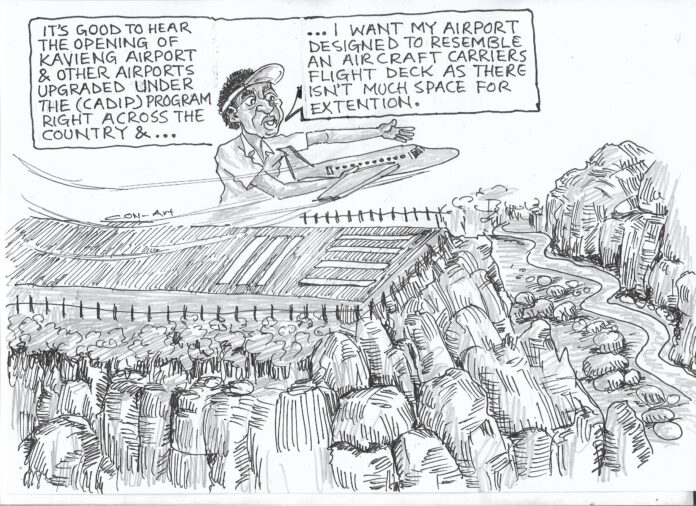THE recent opening of Kavieng Airport and other airports that were upgraded under the Civil Aviation Development Investment Program (CADIP) is really a testament to what the Government is doing to address aging civil aviation infrastructures across the national airports, which is owned and operated by the National Airports Corporation.
CADIP, is the largest civil aviation investment undertaken by the Government with support from the Asian Development Bank and implemented by the National Airports Corporation (NAC). The concept was initiated by late Grand Chief Sir Michael Somare and implemented by the Marape-Rosso Government.
It has been a long time coming for the improvement of these infrastructures and with the help from the National Government as well as the Provincial Government, most of our airports will be upgraded to international standard.
CADIP was initiated by the Government with the support of ADB in 2009, at the cost of KI .67 billion. The implementation of CADIP aligns with the Government’s Vision 2050 and as further detailed in the Medium-Term Development Plan III 2018 – 2022 to improve the country’s 22 national airports to ensure they meet the International Certification Standards.
The success of CADIP is evident in the improved runways and aprons that can accommodate jet and other unrestricted aircraft, new state-of-the-art terminal buildings, installation of security fencing to secure airport perimeters, and other associated works. The Kavieng Airport upgrade is part of this success.
Meanwhile, early this year, NAC with key partners in the CADIP programme signed an MOU for Phase-2 of CADIP. The MoU is a result of a series of discussions between the Asian Development Mission (the Mission) and the Government agencies (Department of Treasury, Department of National Planning and Monitoring; Department of Transport), aviation entities (National Airports Corporation, NiuSky Pacific Limited, Civil Aviation Safety Authority, PNG Accident Investigation Commission) and other key stakeholders.
It (MoU) contains information on the ABD Mission’s findings and agreements reached with the Government on the following; Project scope of works; Cost estimates and financings plans; Implementation arrangements; Project due diligence; Proposed loan assurances and conditions Draft project administration manual; and; Loan processing schedule.
The proposed CADIP Phase 2, is expected to be financed at an estimated cost of USD$171.5 million (K606bil) (ADB loan of USD$ 162.9 (K575 and the Government’s counterpart funding of USD$8.6 million (K30.39bil).
This means the ADB’s ordinary capital resources loan will be 95% of the total cost whilst the Government’s component will be 5% of the overall cost.
The loan will finance identified projects by National Airports Corporation (NAC), Niusky Pacific Limited (NSPL), Civil Aviation Safety Authority (CASA), PNG Accident Investigation Commission (AIC), National Weather Service (NWS) and Rural Airstrip Agency (RAA) under the following scope; civil works, goods and equipment, consulting services and capacity building.
The implementation period of the second phase will be five (5) years with the loan envisaged to take effect in December 2022. However, prior to that the proposed loan will go through ADB’s approval process which include; interdepartmental review then an internal loan negotiation will be conducted, then the ADB Board’s approval and finally the loan will become effective afterwards. All projects are expected to be completed by the 30th June, 2028 with the loan closing on the 31st December, 2028.
CADIP is said to create a more sustainable civil aviation network which will support economic growth and reduce poverty in project areas by providing safer, more-efficient, and accessible all-weather air transport services in the project areas. Additionally, it can also support tourism development. Therefore, we hope that our people will use this infrastructure to maximise their province’s economic capabilities which will in turn benefit the country as a whole.


